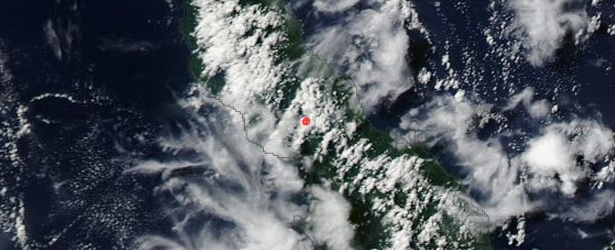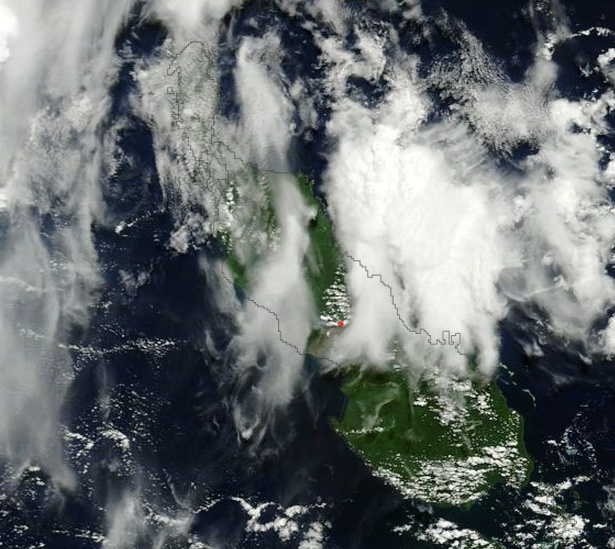Increased volcanic activity observed at Bagana, New Guinea

A significant ash plume reaching 7.6 km (25 000 feet) has been observed on satellite imagery taken above Bagana volcano on August 12, 2014. Darwin VAAC reported ash drifting 167 km southwest and raised Aviation Color Code to Red. It was lowered to Orange on August 13.
VolcanoDiscovery reports that it is still unknown what type of activity was producing the ash plumes. A thermal anomaly is visible on satellite imagery from August 11 (above) and 13 (below), suggesting that the volcano has entered a phase of significant lava dome growth that produces explosions and/or collapse events that result in ash plumes.
Latest addition to GVP's weekly volcanic activity report for this volcano was during the week of August 6 – 12, 2014:
During 6-12 August, DMPGM reported increasing volcanic activity at Bagana volcano. Thin to thick white vapor plumes from Bagana were accompanied on 6, 8 August by reports of rockfalls. On 10 August an ash plume rose to an estimated several hundred meters above the crater drifting SW and W. Moderate ash was reported in Wakovi (6 km W) and decreased downwind.
Residents were advised to evacuate to Gotana (9 km SW) if ashfall continued. On 11 August the Darwin VAAC reported ash plumes rose to 3 km (10,000 ft) a.s.l. and drifted up to 55 km SW.

Thermal anomaly observed at Bagana volcano, New Guinea, on August 13, 2014. Image credit: NASA Terra/MODIS
Geologic summary
Bagana volcano, occupying a remote portion of central Bougainville Island, is one of Melanesia's youngest and most active volcanoes. Bagana is a massive symmetrical, roughly 1750-m-high lava cone largely constructed by an accumulation of viscous andesitic lava flows. The entire lava cone could have been constructed in about 300 years at its present rate of lava production.
Eruptive activity at Bagana is frequent and is characterized by non-explosive effusion of viscous lava that maintains a small lava dome in the summit crater, although explosive activity occasionally producing pyroclastic flows also occurs. Lava flows form dramatic, freshly preserved tongue-shaped lobes up to 50-m-thick with prominent levees that descend the volcano's flanks on all sides. (GVP)
Featured image: NASA Aqua/MODIS with Fire and thermal anomalies layer acquired on August 11, 2014.

Commenting rules and guidelines
We value the thoughts and opinions of our readers and welcome healthy discussions on our website. In order to maintain a respectful and positive community, we ask that all commenters follow these rules:
We reserve the right to remove any comments that violate these rules. By commenting on our website, you agree to abide by these guidelines. Thank you for helping to create a positive and welcoming environment for all.